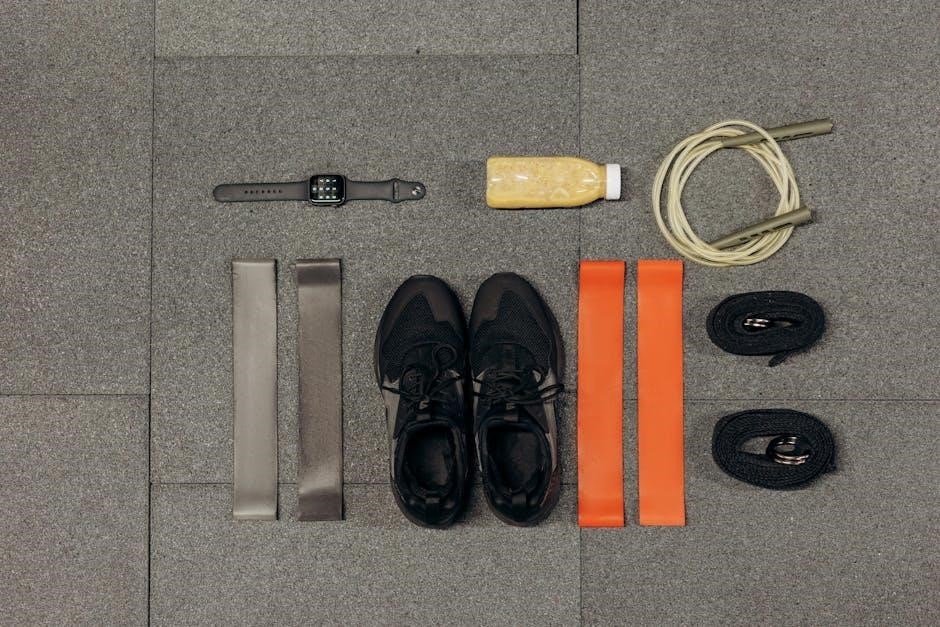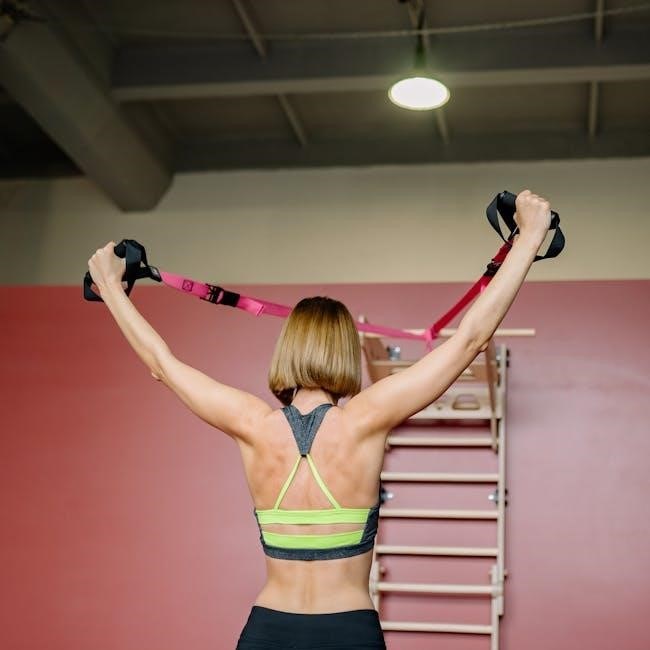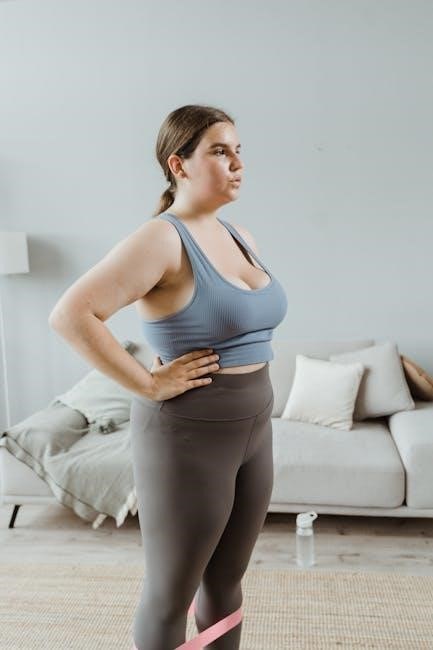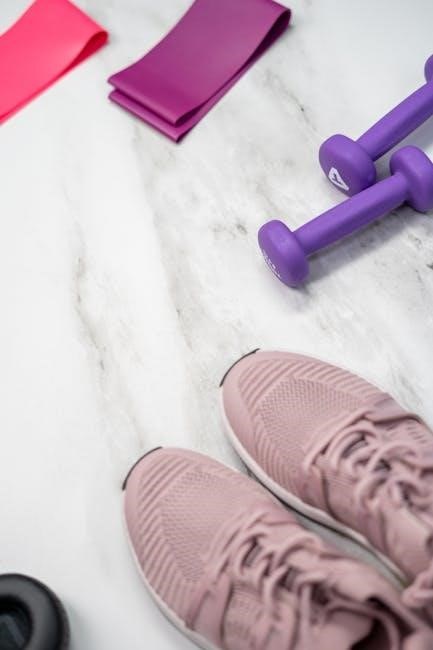Resistance band workouts offer a versatile, portable, and cost-effective way to build strength and improve flexibility. Perfect for home or travel, they suit all fitness levels.
What Are Resistance Bands?
Resistance bands are lightweight, portable, and versatile exercise tools made from durable rubber or latex. They come in various forms, including flat loops, tubes with handles, or mini bands. These bands provide resistance when stretched, targeting specific muscle groups during exercises. They are ideal for strength training, flexibility, and rehabilitation. Resistance bands are cost-effective, space-saving, and suitable for all fitness levels, making them perfect for home workouts or travel; Available in different resistance levels, they allow users to progressively challenge themselves. Whether you’re a beginner or an advanced athlete, resistance bands offer a practical and efficient way to achieve fitness goals without bulky equipment.
Benefits of Using Resistance Bands
Resistance bands offer numerous benefits, making them a popular choice for fitness enthusiasts. They are portable, allowing workouts anywhere, and affordable compared to traditional gym equipment. Bands provide a full-body workout, targeting multiple muscle groups simultaneously. They enhance strength, flexibility, and balance, making them ideal for both beginners and advanced users. Low-impact resistance band exercises are gentle on joints, suitable for rehabilitation or those with mobility issues. Progression is easy with adjustable resistance levels, enabling users to gradually increase intensity. Additionally, they improve functional fitness, mimicking real-life movements, and are space-efficient for home use. Overall, resistance bands are a versatile, effective, and convenient tool for achieving diverse fitness goals without compromising on results.
Types of Resistance Band Exercises
Resistance band exercises include upper, lower body, and core workouts. Portable and versatile, they target multiple muscles, enhance flexibility, and build strength effectively anywhere.
Upper Body Exercises
Resistance bands offer a variety of effective upper body exercises to target muscles like the chest, shoulders, and arms. Popular exercises include chest flys, bicep curls, shoulder presses, and tricep extensions. These exercises can be modified to suit different fitness levels by adjusting the resistance level or the range of motion. For example, chest flys work the pectoral muscles, while bicep curls focus on building arm strength. Shoulder presses are great for improving posture and overall shoulder stability. Tricep extensions target the back of the arms, helping to tone and strengthen them. These exercises are easy to perform at home or while traveling, making them a convenient option for a full upper body workout.

Lower Body Exercises
Resistance bands are excellent for targeting the lower body, with exercises like squats, hamstring curls, and lateral band walks. Squats work the quadriceps and glutes, while hamstring curls isolate the back of the thighs. Lateral band walks improve hip stability and strengthen the gluteus medius. Donkey kickbacks and leg side abductions are also effective for toning the glutes and hips. These exercises can be modified to suit different fitness levels by adjusting the resistance or range of motion. They are ideal for improving functional strength, balance, and flexibility. Resistance band lower body workouts are convenient for home training and can be combined with upper body exercises for a full-body routine. They offer a portable and efficient way to strengthen the legs and hips without heavy equipment.
Core and Functional Exercises
Resistance bands are ideal for strengthening the core and improving functional fitness. Exercises like banded planks target the abs and obliques, while enhancing stability. Russian twists and banded leg raises engage the entire core, boosting balance and posture. Functional exercises such as banded rotations and woodchoppers mimic real-life movements, improving rotational strength and flexibility. These exercises can be done anywhere and are perfect for all fitness levels. Incorporating core and functional exercises with resistance bands helps improve overall stability, reduces injury risk, and enhances athletic performance. They are a great addition to any workout routine, providing a challenge without the need for heavy equipment. Resistance bands make core training versatile, effective, and accessible for everyone. Consistency with these exercises leads to a stronger, more stable core and better overall functional fitness. This makes them a key component of a well-rounded fitness program.

How to Choose the Right Resistance Band
Selecting the right resistance band involves considering resistance levels, material durability, and portability. Opt for bands with multiple resistance options or interchangeable handles. They are versatile, lightweight, and easy to use for any fitness level, making them perfect for home or travel workouts. Resistance bands are also cost-effective and space-saving, ideal for those with limited equipment. Additionally, they can be easily customized to suit your fitness goals, whether strength training or rehabilitation. Always choose high-quality bands to ensure safety and longevity. Resistance bands are a great alternative to traditional weights, offering a full-body workout anywhere.

Understanding Resistance Levels
Resistance bands come in various levels, typically indicated by color. Lighter colors, like yellow or pink, offer less resistance, while darker colors, such as black or red, provide more. These levels are designed to suit different fitness goals and muscle groups. Beginners often start with lighter bands to build foundational strength, gradually moving to heavier ones as they progress. Using multiple bands together can increase resistance for more challenging workouts. Proper selection ensures effective exercises and prevents injury. Always choose a resistance level that matches your current strength and goals, allowing for smooth progression and optimal results. This versatility makes resistance bands ideal for any fitness journey.

Choosing the Best Band for Your Workout Goals
Selecting the right resistance band depends on your fitness objectives and current strength level. For full-body workouts, opt for versatile loop bands. These are ideal for exercises like squats, chest presses, and rows. If targeting specific muscle groups, consider tube bands with handles for controlled movements. Lighter resistance is perfect for flexibility and endurance, while heavier bands build muscle mass. Beginners should start with lower resistance to master form and technique. Advanced users can combine multiple bands for increased intensity. Additionally, bands made from durable materials ensure longevity and safety. Always choose bands that align with your workout goals to maximize efficiency and achieve desired results effectively.
Designing a Resistance Band Workout Routine
Create a balanced routine by targeting different muscle groups with compound and isolation exercises. Include warm-ups, progressive resistance, and cooldowns to ensure safety and effectiveness in your workouts.
Full-Body Workout Plan
A full-body resistance band workout plan is ideal for those seeking efficiency and convenience. It combines upper and lower body exercises to engage all major muscle groups. Start with compound movements like banded squats, chest presses, and rows to build foundational strength. Include isolation exercises such as bicep curls, tricep extensions, and lateral band walks for targeted muscle development. Aim for 3-4 sets of 10-15 reps per exercise, progressing gradually. Incorporate dynamic stretches and mobility work to enhance flexibility and prevent injury. Finish with cooldown stretches to aid recovery. This structured approach ensures a balanced and effective workout, making it perfect for individuals with limited time or space. Customize the plan based on fitness goals and resistance levels for optimal results.
Split Routine for Upper and Lower Body
A split routine divides workouts into upper and lower body sessions, allowing focused training and recovery. For the upper body, perform exercises like banded chest presses, shoulder presses, and rows. Include bicep curls and tricep extensions for isolation work. On lower body days, focus on banded squats, lunges, and hamstring curls. Add lateral band walks and glute kickbacks for hip and glute engagement. Alternate between upper and lower body days, ensuring rest days for recovery. This method enhances muscle development and prevents overtraining. Adjust resistance levels and volume based on progress, ensuring a balanced and effective workout plan tailored to individual goals. Consistency and proper form are key for achieving desired results.
Progressive Overload with Resistance Bands

Progressive overload involves gradually increasing resistance or volume to challenge muscles. Use thicker bands, add reps, or shorten rest periods to enhance strength and muscle growth effectively.
Increasing Resistance Levels
Increasing resistance levels is key to progressive overload. Start with lighter bands and gradually move to thicker ones as strength improves. For added challenge, combine multiple bands or adjust anchor points. This ensures continuous muscle engagement and growth. Over time, higher resistance levels will enhance strength and muscle endurance. Always assess your current fitness level to choose appropriate bands, ensuring safe and effective progression in your workouts. This method is both efficient and scalable, making resistance bands a versatile tool for any fitness journey.
Adding Volume and Intensity
To enhance your resistance band workouts, increase volume by boosting the number of sets, reps, or exercises. For intensity, incorporate tempo variations or pause techniques. Add compound movements like bent-over rows and squats to target multiple muscle groups. Progress by shortening rest periods or using isometric holds. For advanced challenges, combine bands for greater resistance or perform explosive movements; These strategies ensure continuous progress and keep workouts engaging; Over time, this approach builds strength, endurance, and muscle definition, making resistance bands a dynamic tool for achieving fitness goals. Always prioritize form to maximize results and prevent injury.

Free Printable Resistance Band Workout PDF

Download a free printable resistance band workout PDF featuring exercises, sets, reps, and muscle targets. Perfect for home workouts, it’s portable and easy to follow anywhere.
What to Include in Your PDF Guide
Your resistance band workout PDF should include a variety of exercises targeting different muscle groups, such as chest presses, bicep curls, squats, and rows. Organize exercises by upper body, lower body, and core workouts for clarity. Add detailed instructions, including sets, reps, and proper form tips. Include visual guides or diagrams to illustrate each exercise. A sample workout routine, like a 5-day split or full-body plan, can help users stay structured. Safety tips and band maintenance advice are essential. Offer customizable templates for users to create their own plans. Finally, include a progress tracker to monitor improvements. This comprehensive guide ensures users have everything needed for effective resistance band training. Make it easy to follow and visually appealing for the best experience.
How to Create a Custom Workout Plan
Start by assessing your fitness level and goals. Choose exercises that target specific muscle groups, such as chest, legs, or shoulders. Organize your routine into upper/lower splits or full-body workouts. Include 3-4 sets of 8-12 reps for strength or 12-15 reps for endurance. Progress by increasing resistance or volume weekly. Example exercises: bicep curls, squats, and chest presses. Track progress in your PDF guide and adjust as needed. A personalized plan ensures you stay motivated and achieve results effectively with resistance bands. This tailored approach keeps your workouts engaging and aligned with your objectives;

Safety Tips for Resistance Band Training
- Always inspect bands for tears or damage before use.
- Start with light resistance and progress gradually.
- Focus on proper form to prevent injury.
- Avoid exercising the same muscle group on consecutive days.
- Stretch after workouts to promote recovery.
Proper Form and Technique
Proper form and technique are essential for safe and effective resistance band workouts. Always engage your core, maintain a neutral spine, and keep movements controlled. Avoid using momentum or jerking the band, as this can lead to injury. Ensure the band is positioned correctly for each exercise, such as keeping it at shoulder height for chest exercises or securing it under your feet for squats. Focus on slow, deliberate movements to maximize muscle engagement. Keep tension on the band throughout the entire range of motion to avoid loss of resistance. Proper alignment and body positioning will help target the correct muscle groups and prevent strain. Start with lighter resistance to master the technique before increasing intensity. Consistent attention to form ensures a productive and injury-free workout routine.
Band Maintenance and Safety Precautions
Regular maintenance and safety precautions are crucial to extend the life of resistance bands and ensure safe workouts. Before each use, inspect the band for signs of wear, such as cracks, frays, or discoloration. Avoid using damaged bands, as they may snap during exercises. Store bands in a cool, dry place away from direct sunlight to prevent degradation. Clean the bands with mild soap and water, avoiding harsh chemicals. Never stretch a band beyond its recommended capacity, as this can cause it to break. Always anchor the band securely and avoid using it near sharp edges or points. When performing exercises, maintain two points of contact with the band to prevent it from slipping. Replace bands periodically based on usage and condition to maintain safety and effectiveness.
